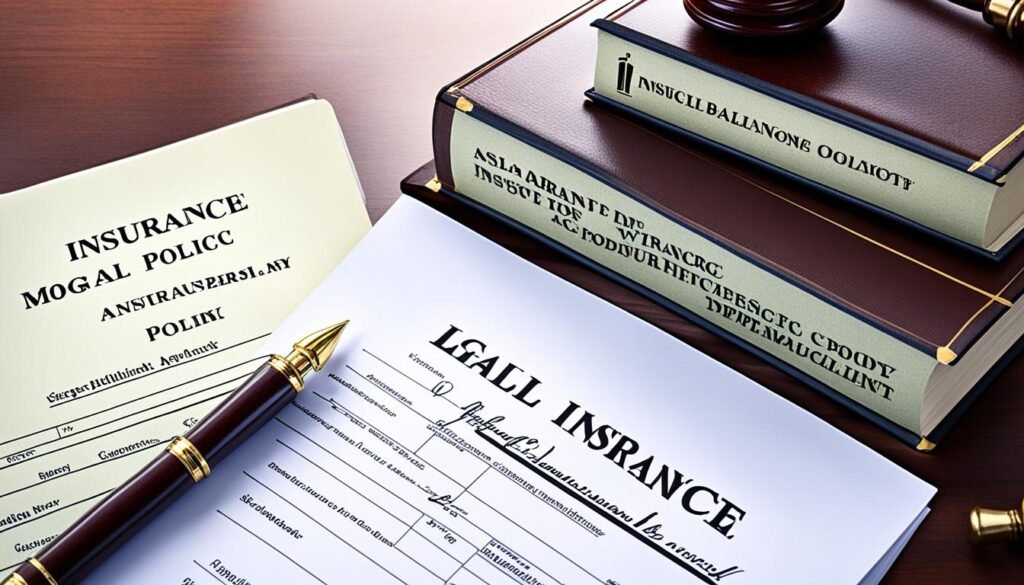An insurance policy is a legal agreement between an insurance company and you, the person, business, or entity getting insured. It lists the coverage, limits, deductibles, and premiums for different risks. By fully understanding your policy, you can prevent issues with the insurer if you need to claim.
There are four main sections in an insurance contract: the Declarations Page, Insuring Agreement, Exclusions, and Conditions. Policies protect against many risks such as life, health, auto, homeowners, renters, business, disability, long-term care, travel, pet, dental, vision, liability, flood, earthquake, and umbrella.
Key Takeaways
- An insurance policy is a legal contract between the insurer and the insured.
- The policy outlines the coverage, limits, deductibles, and premiums for various types of risks.
- The four basic parts of an insurance contract are the Declarations Page, Insuring Agreement, Exclusions, and Conditions.
- Insurance policies can provide coverage for a wide range of risks, including life, health, auto, homeowners, and more.
- Understanding the entire insurance policy can help the insured avoid problems and disagreements with the insurance company.
Understanding Insurance Policy Basics
Insurance policies are like legal contracts. They are really important for protecting people, businesses, and groups. A policy tells you what’s covered, how much is paid, and what you need to pay.
Definition of an Insurance Policy
When you have an insurance policy, it means an insurance company will help you with costs if something bad happens. This helps the insured person or business handle risks without losing a lot of money.
Purpose of Insurance Policies
The main goal of insurance is to keep people safe from huge financial hits. If you’re covered, you don’t have to worry as much about things going wrong. It helps with life, health, and property risks.
Types of Insurance Policies
There are many insurance types to fit different needs. For example, life, health, and car insurance help with personal risks. There’s also business insurance for companies.
- Life insurance
- Health insurance
- Auto insurance
- Homeowners insurance
- Renters insurance
- Business insurance
- Disability insurance
- Long-term care insurance
- Travel insurance
- Pet insurance
- Dental insurance
- Vision insurance
- Liability insurance
- Flood insurance
- Earthquake insurance
- Umbrella insurance
Each type of insurance has its own special benefits. They are meant to help with different kinds of risks you might face.
Key Components of an Insurance Policy

When you look at an insurance policy, knowing its main parts is crucial. It has four main elements: the Declarations Page, Insuring Agreement, Exclusions, and Conditions. These are key in showing what the policy covers and what it doesn’t.
Declarations Page
The Declarations Page shows who’s covered, what’s covered, and for how much. It lists the policy details like the policy number and dates of coverage. This page gives you the basic facts about your insurance.
Insuring Agreement
The Insuring Agreement summarizes what the insurance company promises. It tells you what the policy covers, such as named risks or all-risk coverage. Knowing this helps understand what your policy protects against.
Exclusions
The Exclusions part lists what is not covered by the insurance policy. It excludes certain risks or types of property. This is key in understanding what the policy won’t pay for.
Conditions
The Conditions section outlines rules that both the insurer and you must follow. It may include steps like filing a claim or protecting your property. These rules are essential for making sure you get what you expect from your policy.
Life Insurance Policies
Life insurance gives a cash payment to loved ones if someone dies. There are two main kinds: term and permanent life insurance. These help families handle costs and debts after a loss.
How Life Insurance Works
When you buy life insurance, you pay the company a fee. They agree to give your beneficiaries a large sum if you die. This can support your family with funeral and debt costs and more.
Term Life vs. Permanent Life Insurance
Term life insurance lasts for a select time, like 1 to 30 years. If the person dies during this time, their family gets the money. Then, there’s permanent life insurance. It lasts a person’s whole life, as long as you keep paying. You can also borrow or withdraw money from these policies.
Choosing between term and permanent life insurance is about what you need and can afford. Term life insurance is cheaper and good for temporary needs. Permanent life insurance costs more but offers lifelong protection and a way to save money.
Insurance Policy

Cost Factors
The cost of an insurance policy changes based on many things. These include what kind of policy it is type of policy, how much coverage it offers, and the extras. These extras are known as riders or endorsements. The health and risk factors of the person getting the insurance matter a lot. For example, term life insurance usually costs less than permanent life insurance. Your age, gender, lifestyle, and health history also affect the price of the policy.
Coverage and Benefits
Insurance policies do more than just protect you. They pay out a death benefit to your loved ones. They cover medical expenses and shield you from liability and property damage. They also offer financial protection for sudden losses or emergencies. What you get from the policy depends on the type of insurance and the company offering it.
| Coverage | Benefits |
|---|---|
| Life Insurance | Death benefit payout to named beneficiaries |
| Health Insurance | Coverage for medical expenses, preventive care, and hospitalization |
| Auto Insurance | Protection against liability, property damage, and collision |
| Homeowners Insurance | Coverage for damage to the home, personal property, and liability |
| Disability Insurance | Income replacement in the event of a disabling injury or illness |
Choosing a Policy and Beneficiaries
When picking an insurance policy, think of your needs, budget, and the best policy type. For example, term life insurance covers specific needs for a set time. On the other hand, permanent life insurance offers coverage for life plus a chance to build cash value.
Selecting the Right Policy
To choose the best insurance, look at how much coverage you need, for how long, and the cost. Do your homework by comparing different policies and companies. Make sure the policy you pick meets your needs by checking all its details.
Naming Beneficiaries
It’s very important to choose who will get the insurance money if something happens to you. Think about who you want this money to go to. Consider your close ones, debts, and your plans for when you’re not here.
Filing an Insurance Claim

When someone with insurance dies, their loved ones should file a claim. They need to contact the insurance company and provide the necessary paperwork. This includes a claim form and a copy of the death certificate.
Claim Process
The first step is the beneficiaries telling the insurance company about the death. The company will give them the forms and tell them what documents are needed. The beneficiaries should send the claim form and the death certificate quickly. The insurance company then has about 30 to 60 days to review the claim.
Required Documentation
What you need to file a claim varies by policy and insurer. You’ll likely need a claim form, a death certificate, and maybe more like medical records. To make things go smoothly, check your policy for a list of everything you need.
Payout Options
After the claim is approved, the insurance company will pay the beneficiaries. They can get the money all at once, in parts, or even as an annuity. Each option has different tax and financial effects. So, it’s wise to think and get advice from a financial expert.
Pre-existing Conditions and Insurance Policies

A pre-existing medical condition doesn’t always stop you from getting insurance coverage. The condition might change the policy you are offered, the amount of coverage, and how much you pay. When you apply for insurance, telling the truth about your health is crucial. Not giving all the details could be seen as lying to get insurance.
Insurance companies look at your health history to figure out coverage and cost. Some plans don’t cover certain conditions. Or they might cost more or offer less for those conditions. It’s key to share all about your health, including treatments and meds.
Some insurers might say they won’t pay for certain conditions at first. But, if you wait 12-24 months, they might help cover it. Or, they might make an exception if you show things are stable or if you’ve been proactive in treating it.
It’s very important for those with pre-existing conditions to carefully check their insurance choices. By working openly with their insurance, they can find the right plan. This plan should offer the needed financial help.
Renewing and Amending Insurance Policies
Insurance policies usually get checked and renewed at the end of their term. Insurers might tweak the policy or coverage during this time. People with insurance should look closely at any changes to make sure they still get what they need.
Policy Endorsements and Riders
Endorsements and riders change or add to a policy’s written rules. They can either boost, limit, or change what the insurance policy covers. It’s important for policyholders to know how endorsements and riders can affect their insurance.
For instance, someone might want to add a rider to their home insurance for better coverage on expensive jewelry. Or an insurer might add a note that says natural disasters like earthquakes aren’t covered. Understanding these changes ensures you’re still getting the protection you want.
When it’s time to renew or update your insurance, talking to your agent is key. They can explain any new changes clearly. Remember, small changes to endorsments and riders can have a big effect on your policy. So, think carefully about them.
Legal and Regulatory Aspects

Insurance policies are more than just pieces of paper. They are like legal agreements. They follow many state and federal laws. The rules about what they must include or not are well set. This makes sure policies are fair and follow the right rules.
Insurance Policy Terms and Conditions
What’s in the insurance policy? It tells you what it covers and doesn’t. There are also details about how the insurance works or when it won’t. It’s really important to read and understand all these details. This way, you know exactly what your policy is there for. Insurance companies have to write their policies in ways that follow the law. This is to make sure things are done the right way.
Regulatory Requirements
Getting the details right isn’t the only rule for insurance companies. They must also follow many other rules. These come from state insurance offices and more. These rules touch on how they sell policies, handle claims, and stay financially strong. Knowing about these rules can help policyholders understand their rights better.
Also Read: Protecting Your Enterprise: Essential Insurance For Small Businesses
Conclusion
Insurance policies offer important financial protection. They are like legal agreements. These policies help people, businesses, and groups manage risks. Knowing the main parts of a policy, like the Declarations Page, can ensure it fits your needs. It’s key to shop around for the right policy, whether for your health, home, or car. Remember, different things can change how much you pay.
Filing an insurance claim is crucial if something goes wrong. Knowing what you need to document and how you’ll be paid is vital. This knowledge can help you work smoothly with your insurance company and prevent disagreements. It’s also good to understand the legal rules and how pre-existing conditions could affect your policy. This way, you can avoid common troubles.
Insurance policies are essential for protecting what matters from the unexpected. Knowing the ins and outs helps you choose wisely. With the right information, you ensure your policy does what you need it to do.
FAQs
What is an insurance policy?
What is the purpose of insurance policies?
What are the main types of insurance policies?
What are the four basic parts of an insurance contract?
How does life insurance work?
What factors affect the cost of an insurance policy?
What should consumers consider when choosing an insurance policy?
How does the insurance claim process work?
How do pre-existing conditions affect insurance coverage?
How can insurance policies be renewed and amended?
What are the legal and regulatory aspects of insurance policies?
Source Links
- https://www.progressive.com/answers/life-insurance-101/
- https://www.investopedia.com/articles/personal-finance/121914/life-insurance-policies-how-payouts-work.asp
- https://www.doi.sc.gov/957/Understanding-Your-Insurance-Policy




